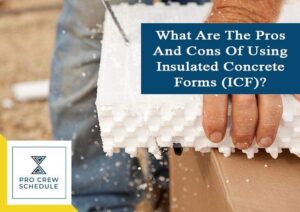The construction industry has gotten a slew of technological developments in recent years, such as effective subcontractor scheduling software, new and sustainable materials, automated machinery, and prefabricated buildings.
Concrete is among the many trades that are continuously advancing. It’s gotten a plethora of complex developments like brick-laying robots. However, there are also other simpler yet beneficial advancements like insulated concrete forms.
What are insulated concrete forms?
Insulated concrete forms, or ICFs, are for cast-in-place reinforced concrete walls. It is a system made up of expanded polystyrene (EPS) rigid insulation blocks that plastic webbing separates.
These forms are used in place of traditional plywood or plank forms for pouring concrete walls. The H-shaped structure allows two concrete walls to be cast between insulation layers while allowing open air.
Finishes like siding or drywall are then attached to fastener strips in the insulation. The forms are permanently left in place for thermal and acoustic insulation, space for plumbing and wiring, and gypsum boards backing inside and other sidings (stucco or brick) outside.
ICFs have been in use since the 1940s and 1950s in the form of treated wood. But many manufactures today have improved on this old system.
The Pros Of Using Insulated Concrete Forms
1. Stronger walls
Arguably, ICFs’ most notable advantage is the improved structural integrity from using a foundational reinforced concrete wall.
The hardened concrete around the ICF strengthens the wall and reduces the vulnerability to horizontal and vertical forces. Depending on the kind of frame the ICF is (grid or flat), the wall can even be stronger with the inner connectors’ frequency and rigidity.
2. Conserves energy and improves air quality
One of the most appealing and impressive characteristics insulated concrete forms have is their ability to significantly reduce a building’s heating and cooling costs. Compared to compatible window and door frames, ICF walls are denser and tighter. Because they are not as porous, less air will be able to move through them. They can store heat in the winter and release that heat in the summer, saving about 20% of energy costs.
For that reason also, the air quality will improve. If the ICFs have a 100-year lifespan and no degradation, one house with ICF walls could save around 110 tons of carbon dioxide.
3. Stabilizes temperature and reduces sound
With layers of materials, ICFs can serve as sound barriers for the interior of the building from outside noises. Furthermore, in concrete, when a huge material combines with a light one (foam), shifts in sound, temperature, and air filtration are significantly reduced.
The insulating foam from an ICF wall helps in stabilizing temperatures, eliminating cold spots from frame walls between insulation gaps and around the studs.
4. Cost-efficient in terms of materials
With an effective tool for project planning and the integration of insulated concrete forms into walls and other parts of the construction process, the project would require about 10% less concrete to set walls and foundations.
When delivered to project sites, ICFs often come as pre-assembled straight-form blocks. According to Green Garage, this removes a few inches of thickness, which can sometimes increase savings on materials and expenses by about 25%.
5. Improved concrete curing time
ICFs can boost curing time by up to 25%. This allows you time to reinforce the structure, an ability most building methods don’t offer.
6. Protects concrete while it cures
ICFs protect the concrete while it cures, which decreases the risk of air bubbles forming and other faults straight-line forms present. Consequently, those problems will incur future issues that will need costly repairs.
7. Less setup time
Insulated concrete forms also benefit construction scheduling. On top of a quicker curing time, workers can create durable, sturdy, and reliable frames for concrete in a fraction of time straight-forms would need.
The crew can finish the building and set processes in one afternoon once the forms are fully stacked.
8. Allows you to install plumbing and wiring
Insulated concrete forms give workers the ability to install plumbing and wiring systems. They can cut grooves in the foam so they can emplace necessary components.
As with conventional structures, the wires or pipes can go through the segment. To seal up any leaks, you can use spray foam insulation. Then shore up the installation with flashing, caulking, or weatherproofing.
Plus, the crawl space can become a functioning area as airflow continues, giving the building occupants access to modern amenities.
Construction crew management will also be easier because the plumbing or wiring team can collaborate with the other workers to produce better and quicker results.
9. You can still use rebar
When the forms are set in place, you can insert rebar reinforcements for the concrete pour. By doing this, you get to take advantage of the reinforcement’s strength and the ICF system’s time benefits.
Since each form interlocks with one another, you can easily stack them in whatever shape needed. Plus, there is a remarkable degree of shock resistance because the forms hold the concrete in place with just bracing assistance from the outside.
The Cons Of Using Insulated Concrete Forms
1. Does not work that well in low temperatures
Hypothetically, ICF walls serve as strong insulators of heat and colder exterior temperatures. But the amount of heat transferred outside is not taken into account. Insulated concrete forms are made to transfer heat from inside the structure, so the temperature outdoors doesn’t affect the curing process negatively.
With that said, ICFs work better in warmer climates where the insulation and heat transfer keeps the building cool in the day and comfortably warm at night.
2. Higher costs from specialized labor
We mentioned that you could save money on materials costs with insulated concrete forms. However, looking at the overall costs, ICFs may cost about 40% more than conventional methods for the final result. This is due to the labor aspect of using this system being costly.
Traditional processes are significantly cheaper than ICFs because their level of specialty labor is relatively basic. On the other hand, the installation of ICFs requires specialized labor, which is not considered cheap.
If your project is located in an area where there are little to no contractors capable of working with ICFs, you may want to think about cheaper methods.
3. Some projects may not be able to add rebar reinforcement
The addition of rebar significantly strengthens the wall. But sometimes, you may find that there isn’t enough room for the correct placement. Many of the ICFs being used today come with plastic connectors, cheaper and more flexible reinforcement wires. The corners are a particular area for concern, as ICFs might be susceptible to structural instability, such as wall seams.
4. Releasing them too early could lead to structural issues
One significant advantage with insulated concrete forms is a quicker curing time. However, releasing them too early can incur structural problems, the same as the traditional straight-line option.
Leaving the concrete to cure in the ICF will result in more strength. However, some concrete workers will release it by as much as 24 hours early to get on with their work.
5. Requires a bracing process
Plenty of ICFs need a bracing system that aligns the walls with being plumb and square. Without this kind of support, the concrete being poured is at risk of blowing out through the interlocking mechanisms. There may still be some leakage if the vertical and horizontal accesses are not correctly aligned with the frame.
Bracing may be considered the most taxing and arduous stage of using ICFs, not the stacking of the forms. Even if the bracing is set up correctly, there may still be some lean that would need to be returned to the correct position.
6. Indoor humidity problems
The foam bracing reduces airflow through the concrete. Because of this, indoor humidity levels are remarkably high. This issue persists as the build continues while the concrete cures. As a solution to manage this complication, you could use an air conditioner or dehumidifier.
7. Future remodeling could be challenging
An often overlooked drawback to using insulated concrete forms is it makes it challenging for future remodeling.
When using ICFs, extra care and detail must be put in the building’s design since you can’t add fixtures, like doors and windows, without cutting through the concrete wall. When managing construction projects under these circumstances, you should consider the various wiring and plumbing installation points to mitigate the problems cutting into the wall brings.
The Bottomline
As with any construction material, insulated concrete forms present advantages and disadvantages. Initially, working with something unfamiliar can be difficult. But when you get used to handling ICFs and become familiar with the necessary steps, you can set them up fairly quickly and begin the pouring process. In the end, the forms can then act as an insulator and additional support.
Are you a concrete contractor looking for effective subcontractor scheduling software? Use Pro Crew Schedule’s Concrete Contractors Software. Sign up today and get a free 30-day trial with all its features and no strings attached. Request a demo now!







